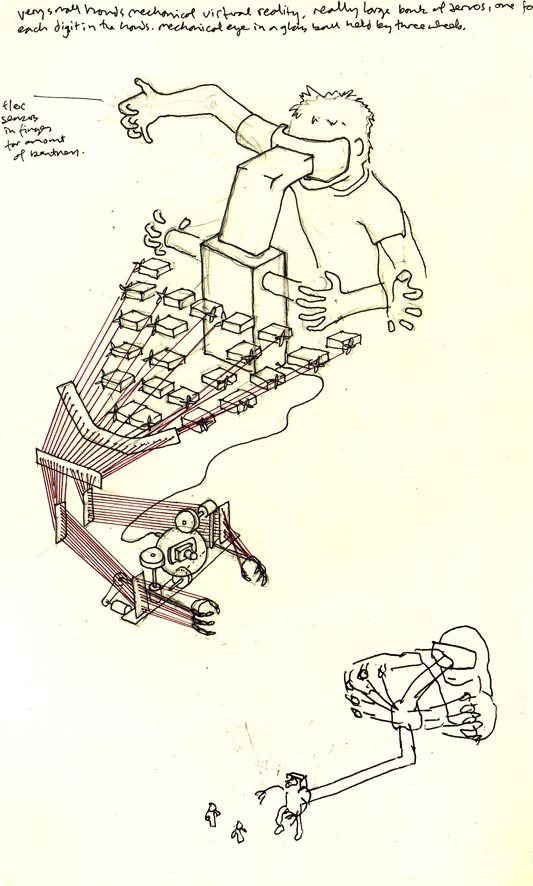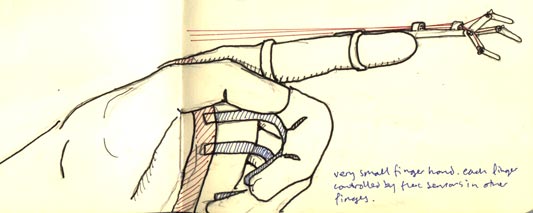So I’ve been thinking about hands and arms. I started by thinking of extremely small hands, on my hands. So here are some drawings from that thinking.

This drawing is of a toy that shrinks your hands down so you can play in a small world, with small figures. Your fingers are all connected up to a group of flex sensors, which converts the analogue movement to a cluster of servos. The servos collectively control fingers on the small hands by tightening or loosening. So the movements of your fingers become roughly and awkwardly analogous to those of the small hands in the toy. There is also a screen inside some goggles hooked up to a small camera in a glass ball between the two small arms. So when you look in to the goggles, you see what is in front of your arms. There are two wheels which you can twist to point the camera in different directions, like an eye. Kind of like an analogue version of virtual reality, only right in front of you and not virtual.

I would also like to have a very small hand at the end of my finger. To pick up pens and things. You control the small hand on one finger using your other fingers, with flex sensors (same as above). You lose one of your big hands to gain a little hand on the end of one of your fingers.
I came across Chad Thornton‘s work. He is at Google now, but he made a mechanical finger as part of his work at Carnegie Mellon Interaction Design programme (nice video here).
Maybe I’m carrying some latent affection for the Radio Shack Armatron here, I don’t know. These themes are common in films. This must be informed by Ripley’s Power Loader from Aliens:
The belt buckle, and rubberised keyboard make her rig seem really convincing, her trainers too, and how she locks into the unit. The cyborg fingers for typing in Ghost in the Shell are nice too.
No doubt there are more. It makes me think of Robocop‘s gun hip too although slightly off topic.
I like them, robot arms. I see them as a celebration of industrial process. I predict they will become a more widespread part of our lives. They are cheaper now (it appears that non-load bearing ones don’t require three phase power either) and since they are multi modal they can perform many tasks, in strange contexts. No doubt FDM or other fittings are/will be available, implications of that could be very large. Imagine a robot arm in your drive thr(o)u(gh), changing a tyre, and then printing out your happy meal. Our lives could become peppered with arrays of multi-buildy-arms.
Robotlab (via Roger Ibars) are a German partnership who have used industrial robot arms to perform a DJ set. Witnessing the arms is as important as their role. I find them disconcertingly accurate, mechanised confidence in something typically so analogue and expert and careful. There is also something about their inflexibility, their inability to reach inside certain arcs, too close to themselves. I like the way they occasionally find a sync with each other, and at other times drift out. I think these guys have a business model set up around this, so I’m very interested to see how that develops.
I want one.
4 Comments and Trackbacks
1. Matt said on 24 October 2006...
On Ripley’s Power Loader:
I love that she has to control the waldo by typing numbers into a keypad. It’s woefully inefficient but somehow makes the whole thing, as a sci-fi artefact, magnitudes more convincing.
What if you had a robot arm prosthetic limb working on the same principle? You’d be typing in with the other hand the whole time, “forward 10, twist 90, yaw 7, left 14, grab.” Picking up a cup of tea would be like programming Big Trak. Mind, you could also have macros for particular gesture patterns: “run ‘flag down cab'”, “run ‘techno dance moves'”. That’d be handy.
2. rodcorp said on 24 October 2006...
These kinds of arm were once called waldos, which came from a Heinlein short sf story ‘Waldo’ in the 40s. The camera lingers lovingly on the waldoing in THX 1138 and the Andromeda Strain, though neither really have the small-scale thing that Heinlein’s story or Ghost in the Shell have.
The power loader in Aliens is good isn’t it: it has to be responsive to Ripley’s set-up – adjusting the joystick positioning to match her arm length etc – ahead of actually starting to operate with her as a true symbiotic exoskeleton thing. A ghost in the shell before the meat arrives…
I think the practice is now more generically known as “tele-factoring”. Which is still a pretty good name.
3. Matt Brown said on 24 October 2006...
Hello – have you seen theseAir Muscles?
4. gavin said on 27 October 2006...
Just came across this via Make’s blog: Magnifying Finger Attachment “This flexible little magnifying glass attaches right to your finger, enlarging your view for sewing, knitting, crafts, and hobby projects.” A step in the right direction….